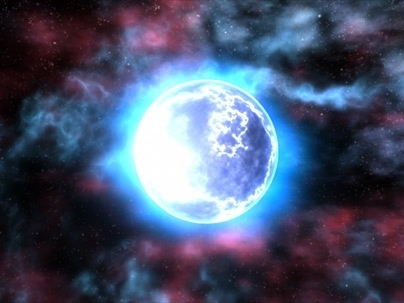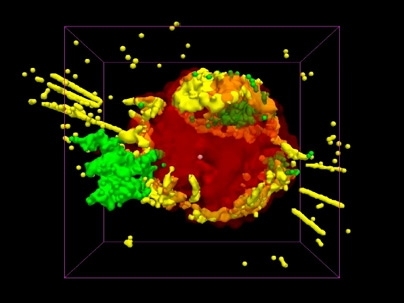Using views captured by several orbiting and ground-based telescopes, an MIT researcher and her colleagues have produced the first fully three-dimensional reconstruction of the remains of a star that exploded in a cosmic cataclysm called a supernova.
The complex supernova remnant, called Cassiopeia A (or Cas A for short), consists of a set of intertwined bubble-like shells of debris that were spewed out by a star undergoing its death throes 330 years ago.
Tracey DeLaney, a postdoctoral researcher in MIT's Kavli Institute for Astrophysics & Space Research, and her colleagues used data from the Chandra orbiting X-ray telescope, along with NASA's Spitzer Space Telescope that detects infrared light, and ground-based optical telescopes, to produce the first three-dimensional fly-through of a supernova remnant. The computer reconstruction was unveiled this week at the American Astronomical Society meeting in Long Beach, Calif.
"We have always wanted to know how the pieces we see in two dimensions fit together with each other in real life," said DeLaney. "Now we can see for ourselves with this 'hologram' of supernova debris."
This ground-breaking visualization of Cas A was made possible through a collaboration with the Astronomical Medicine project based at Harvard. The goal of the project is to bring together the best techniques from two very different fields, astronomy and medical imaging.
"Right now, we are focusing on improving three-dimensional visualization in both astronomy and medicine," said Harvard's Alyssa Goodman, who heads the Astronomical Medicine project. "This project with Cas A is exactly what we have hoped would come out of it."
While these are stunning visuals, the 3-D model from DeLaney, along with another new reconstruction of Cas A by a team at Harvard that shows how it has changed over time, are rich resources for science. The two teams are trying to get a much more complete understanding of how this famous supernova explosion and its remnant work.
The new 3-D model of Cas A provides researchers with unique ability to study this remnant. With this new tool, DeLaney and colleagues found two components to the explosion, a spherical component from the outer layers of the star and a flattened component from the inner layers of the star.
Notable features of the model are high-velocity plumes from this internal material that are shooting out from the explosion. Plumes, or jets, of silicon appear in the northeast and southwest, while plumes of iron are seen in the southeast and north. Astronomers had known about the plumes and jets before, but did not know that they all came out in a broad, disk-like structure.
The implication of this work is that astronomers who build models of supernova explosions must now consider that the outer layers of the star come off spherically, but the inner layers come out more disk like with high-velocity jets in multiple directions.
Cassiopeia A is the remains of a star thought to have exploded about 330 years ago, and is one of the youngest remnants in the Milky Way galaxy. The study of Cas A and remnants like it help astronomers better understand how the explosions that generate them seed interstellar gas with heavy elements, heat it with the energy of their radiation, and trigger shock waves from which new stars form.
Lawrence Rudnick of the University of Minnesota led the Spitzer part of the DeLaney study. NASA's Marshall Space Flight Center in Huntsville, Ala., manages the Chandra program for NASA's Science Mission Directorate in Washington. The Smithsonian Astrophysical Observatory controls Chandra's science and flight operations from Cambridge, Mass.
A version of this article appeared in MIT Tech Talk on January 14, 2009 (download PDF).







